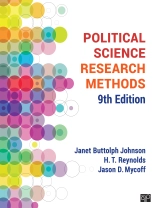‘This is a solid text that walks students through the entire process of empirical, quantitative research methods in political science without being too math-heavy. Students will be able to read this book and come away with an increased understanding of how we use research methods in political science.’
—Amanda M. Rosen,
Webster University
Understand the ‘how’ and the ‘why’ behind research in political science.
Political Science Research Methods helps students to understand the logic behind research design by guiding them through a step-by-step process that explains when and why a researcher would pursue different kinds of methods. The highly anticipated
Ninth Edition of this trusted resource provides more international examples, an increased focus on the role ethics play in the research process, increased attention to qualitative research methods, and expanded coverage on the role of the internet in research and analysis.
A Complete Teaching & Learning Package
SAGE coursepacks
FREE! Easily import our quality instructor and student resource content into your school’s learning management system (LMS) and save time. .
SAGE edge
FREE online resources for students that make learning easier.
Cuprins
Tables, Figures, and Features
Preface
About the Authors
Chapter 1 • Introduction
Research on Income Inequality
Politics and the Gender Gap
The Case of Italian (Non) Tax Compliance
Protests and Repression in New Democracies
The Observer Effect in International Politics: Evidence from a Natural Experiment
Conclusion
Terms Introduced
Chapter 2 • The Empirical Approach to Political Science
Elements of Empiricism
The Importance of Theory
A Brief Overview of the Empirical Research Process
Reactions to the Empirical Approach: Practical Objections
Competing Points of View
Conclusion
Terms Introduced
Suggested Readings
Chapter 3 • Beginning the Research Process: Identifying a Research Topic, Developing Research Questions, and Reviewing the Literature
Specifying the Research Question
Sources of Ideas for Research Topics
Why Conduct a Literature Review?
Collecting Sources for a Literature Review
Writing a Literature Review
Anatomy of a Literature Review
Conclusion
Terms Introduced
Suggested Readings
Chapter 4 • The Building Blocks of Social Scientific Research: Hypotheses, Concepts, Variables, and Measurement
Proposing Explanations
Formulating Hypotheses
Defining Concepts
Devising Measurement Strategies
The Accuracy of Measurements
The Precision of Measurements
Conclusion
Terms Introduced
Suggested Readings
Chapter 5 • Sampling
The Basics of Sampling
How Do We Use a Sample to Learn About a Population?
Sampling Methods
Types of Samples
Conclusion
Terms Introduced
Suggested Readings
Chapter 6 • Research Design: Establishing Causation
Verifying Causal Assertions
Qualitative and Quantitative Methods and Analysis: Causes-of-Effects and Effects-of-Causes Approaches
Conclusion
Terms Introduced
Suggested Readings
Chapter 7 • Qualitative Research: Case Study Designs
Case Study Methods
Case Study Types
Using Cases to Explore Causal Mechanisms: Process Tracing
Generalizing from Cases Studies
Conclusion
Terms Introduced
Suggested Readings
Chapter 8 • Making Empirical Observations: Qualitative Analysis
Types of Data and Collection Techniques
Data Collection in Qualitative Research
Conclusion
Terms Introduced
Suggested Readings
Chapter 9 • Quantitative Research Designs
Randomized Experimental Designs
Natural Experiments
Nonrandomized Designs: Quasi-Experiments
Observational Studies
Conclusion
Terms Introduced
Suggested Readings
Chapter 10 • Quantitative Methods
The Wide Variety of Quantitative Projects
Sources of Data for Quantitative Studies
Data Management
Ethical Concerns with Quantitative Methods
Conclusion
Terms Introduced
Suggested Readings
Chapter 11 • Making Sense of Data: First Steps
The Data Matrix
Descriptive Statistics
Graphs for Presentation and Exploration
Conclusion
Terms Introduced
Suggested Readings
Chapter 12 • Testing Relationships
The Normal Distribution and z Scores
Confidence Intervals
Hypothesis Testing
Testing a Relationship with Two Samples
Conclusion
Terms Introduced
Suggested Readings
Chapter 13 • Analyzing Relationships for Categorical Data
The Basics of Identifying and Measuring Relationships
Table Summaries of Categorical Variable Associations
Measuring Strength of Relationships in Tables
Measures of Association: Statistics for Reporting the Strength of Relationships in Tables
Chi Square Test for Independence
Multivariate Analysis of Categorical Data
Analysis of Variance: Analyzing the Difference between Means for More Than Two Means
Conclusion
Terms Introduced
Suggested Readings
Chapter 14 • Regression
Logic of Regression
Minimizing the Sum of the Squared Error
The Linear Regression Model
Maximum Likelihood Models for Dichotomous Dependent Variables
Conclusion
Terms Introduced
Suggested Readings
Chapter 15 • The Research Report: An Annotated Example
Annotated Research Report Example
Appendixes
Appendix A: Normal Curve Tail Probabilities
Appendix B: Critical Values from t Distribution
Appendix C: Chi-Squared Distribution Values for Various Right-Tail Probabilities
Appendix D: F Distribution
Glossary
Index
Despre autor
Jason Mycoff is associate professor of political science and international relations at the University of Delaware. His research is on American political institutions, in particular the US Congress, congressional committees, and parties.












